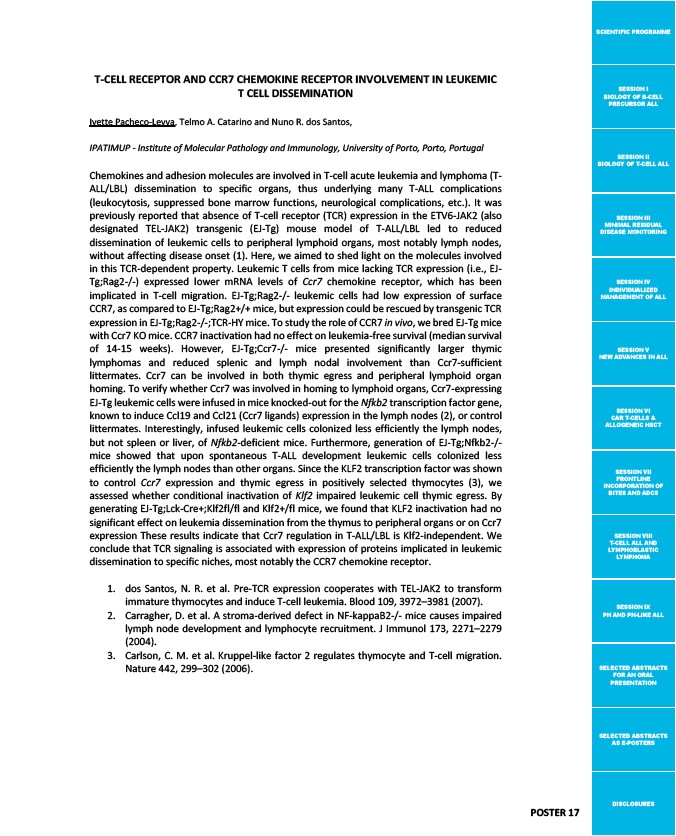
SCIENTIFIC PROGRAMME
SESSION I
BIOLOGY OF B-CELL
PRECURSOR ALL
SESSION II
BIOLOGY OF T-CELL ALL
SESSION III
MINIMAL RESIDUAL
DISEASE MONITORING
SESSION IV
INDIVIDUALIZED
MANAGEMENT OF ALL
SESSION V
NEW ADVANCES IN ALL
SESSION VI
CAR T-CELLS &
ALLOGENEIC HSCT
SESSION VII
FRONTLINE
INCORPORATION OF
BITES AND ADCS
SESSION VIII
T-CELL ALL AND
LYMPHOBLASTIC
LYMPHOMA
SESSION IX
PH AND PH-LIKE ALL
SELECTED ABSTRACTS
FOR AN ORAL
PRESENTATION
SELECTED ABSTRACTS
AS E-POSTERS
DISCLOSURES
T-CELL RECEPTOR AND CCR7 CHEMOKINE RECEPTOR INVOLVEMENT IN LEUKEMIC
T CELL DISSEMINATION
Ivette Pacheco-Leyva, Telmo A. Catarino and Nuno R. dos Santos,
I
PATIMUP - Institute of Molecular Pathology and Immunology, University of Porto, Porto, Portugal
Chemokines and adhesion molecules are involved in T-cell acute leukemia and lymphoma (T-ALL/
LBL) dissemination to specific organs, thus underlying many T-ALL complications
(leukocytosis, suppressed bone marrow functions, neurological complications, etc.). It was
previously reported that absence of T-cell receptor (TCR) expression in the ETV6-JAK2 (also
designated TEL-JAK2) transgenic (EJ-Tg) mouse model of T-ALL/LBL led to reduced
dissemination of leukemic cells to peripheral lymphoid organs, most notably lymph nodes,
without affecting disease onset (1). Here, we aimed to shed light on the molecules involved
in this TCR-dependent property. Leukemic T cells from mice lacking TCR expression (i.e., EJ-Tg;
Rag2-/-) expressed lower mRNA levels of Ccr7 chemokine receptor, which has been
implicated in T-cell migration. EJ-Tg;Rag2-/- leukemic cells had low expression of surface
CCR7, as compared to EJ-Tg;Rag2+/+ mice, but expression could be rescued by transgenic TCR
expression in EJ-Tg;Rag2-/-;TCR-HY mice. To study the role of CCR7 in vivo, we bred EJ-Tg mice
with Ccr7 KO mice. CCR7 inactivation had no effect on leukemia-free survival (median survival
of 14-15 weeks). However, EJ-Tg;Ccr7-/- mice presented significantly larger thymic
lymphomas and reduced splenic and lymph nodal involvement than Ccr7-sufficient
littermates. Ccr7 can be involved in both thymic egress and peripheral lymphoid organ
homing. To verify whether Ccr7 was involved in homing to lymphoid organs, Ccr7-expressing
EJ-Tg leukemic cells were infused in mice knocked-out for the Nfkb2 transcription factor gene,
known to induce Ccl19 and Ccl21 (Ccr7 ligands) expression in the lymph nodes (2), or control
littermates. Interestingly, infused leukemic cells colonized less efficiently the lymph nodes,
but not spleen or liver, of Nfkb2-deficient mice. Furthermore, generation of EJ-Tg;Nfkb2-/-
mice showed that upon spontaneous T-ALL development leukemic cells colonized less
efficiently the lymph nodes than other organs. Since the KLF2 transcription factor was shown
to control Ccr7 expression and thymic egress in positively selected thymocytes (3), we
assessed whether conditional inactivation of Klf2 impaired leukemic cell thymic egress. By
generating EJ-Tg;Lck-Cre+;Klf2fl/fl and Klf2+/fl mice, we found that KLF2 inactivation had no
significant effect on leukemia dissemination from the thymus to peripheral organs or on Ccr7
expression These results indicate that Ccr7 regulation in T-ALL/LBL is Klf2-independent. We
conclude that TCR signaling is associated with expression of proteins implicated in leukemic
dissemination to specific niches, most notably the CCR7 chemokine receptor.
1. dos Santos, N. R. et al. Pre-TCR expression cooperates with TEL-JAK2 to transform
immature thymocytes and induce T-cell leukemia. Blood 109, 3972–3981 (2007).
2. Carragher, D. et al. A stroma-derived defect in NF-kappaB2-/- mice causes impaired
lymph node development and lymphocyte recruitment. J Immunol 173, 2271–2279
(2004).
3. Carlson, C. M. et al. Kruppel-like factor 2 regulates thymocyte and T-cell migration.
Nature 442, 299–302 (2006).
POSTER 17